Adults aged 65 and older are more likely to be hospitalized or die from foodborne illness. This increased risk of foodborne illness is because organs and body systems go through changes as people age:
- The body's immune response to disease grows weaker.
- The gastrointestinal tract holds onto food for a longer period of time, allowing bacteria to grow.
- The liver and kidneys may not properly rid the body of foreign bacteria and toxins.
- The stomach may not produce enough acid. The acidity helps to reduce the number of bacteria in our intestinal tract.
- Underlying chronic conditions, such as diabetes and cancer, may also increase a person's risk of foodborne illness.
Download the USDA's Food Safety: A Need-to-Know Guide for Those At-Risk.
Choose Safer Food
Learn about safer food choices for older adults who have a higher risk of getting very sick from foodborne germs, such as Listeria.
If you are 65 or older, or prepare food for someone who is, always follow the four steps:
- Clean: Wash hands, utensils and surfaces often. Germs can spread and survive in many places.
- Separate: Raw meat, poultry, seafood, and eggs can spread germs to ready-to-eat foods, so keep them separate.
- Cook: Food is safely cooked only when the internal temperature is high enough to kill germs that can make you sick.
- Chill: Refrigerate perishable food within 2 hours. If the food is exposed to temperatures above 90°F (32°C) (like a hot car or picnic), refrigerate it within 1 hour.
Date Last Reviewed


